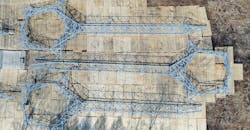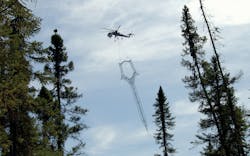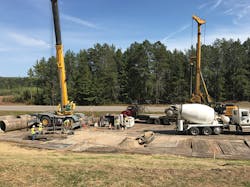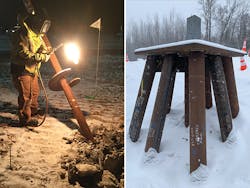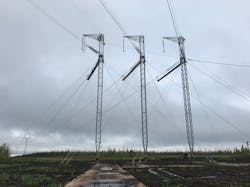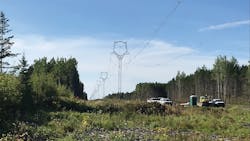Challenging Terrain for a Transmission Build
Minnesota Power is designing and building the 224-mile (360 km), 500-kV Great Northern Transmission Line through some of the most extensive peat bogs found in the U.S.’s lower 48 states. More often suited for boats than trucks, the ground gives walkers a water-cushioned bounce as their footprints fill in with a tannin-stained brew. Some stretches of the project route — chosen based on local community input, in part because it would reduce landowner impacts — are so remote some of the project sites do not have roads nearby.
Traversing these long stretches of wet and soggy no-man’s land, Minnesota Power installed hundreds of foundations at the only time of year the ground is solid: in the wintertime. Besides battling the bogs, the utility had to contend with intense cold, deep snow and an extremely limited construction window. The Great Northern Transmission Line (GNTL) is set to connect Minnesota Power to Manitoba Hydro across the U.S.-Canadian border. The line will connect on the border near Roseau, Minnesota, U.S., to Minnesota Power’s new 500/230-kV Iron Range substation in Blackberry Township, near Grand Rapids, Minnesota.
When finished in 2020, GNTL will deliver up to 883 MW of hydropower to northern Minnesota, enabling Minnesota Power to diversify its energy sources, meet increasing demand, and supplement system reliability. To support the development and design of GNTL, the utility engaged POWER Engineers Inc. for owner’s engineering, detailed transmission and substation design, and program and construction support services.
Challenging Environment
Engineers divided the long project route into four more easily managed and relatively equal segments. The northern and southern segments contained fewer bogs than the two segments in the middle. As the design phase got underway, surveying the route and peat investigations offered their own set of challenges.
Minnesota’s bogs sit on the southeast side of the long-gone glacial Lake Agassiz (GLA). This immense ancient glacial lake was larger than all the Great Lakes combined and held more water than all lakes in the world today. As GLA drained about 8500 years ago, the area slowly filled in with wetland plants. This former lake bottom exhibits a variety of geologic features like the rare string bog, which consists of slightly elevated ridges and islands with woody plants alternated by flat, wet sedge mat areas.
These peat bogs are a type of wetland where water does not drain through the soil, but instead covers plant matter and prevents it from fully decomposing. The partially decayed plant matter is spongy and difficult to drive on or use as a foundation for construction. In areas where the transmission line runs, the peat generally is 3 ft to 5 ft (1 m to 1.5 m) deep, although some areas of peat bogs are up to 15 ft (4.5 m) deep. In other areas, the peat bogs are considered bottomless, at 40 ft (12 m) or deeper. Routes for the transmission line and access roads needed to avoid the so-called bottomless areas. About 80% of the line crosses these wetlands.
In-Depth Investigation
To go where few have gone, crews surveying the planned route through the bogs used low-ground-pressure, all-terrain vehicles (ATVs). Approved by the Minnesota Department of Natural Resources, ATVs have less effect on the environment than other vehicles. Away from areas served by cell phone coverage, the survey crews equipped themselves with global positioning system (GPS) trackers that created maps, which enabled them to retrace their path out of an area or return to it later. Aerial photographs provided Minnesota Power and POWER an up-to-date image of the planned corridor.
To gather the most valuable information on peat depth, a team directed by POWER made manual probes and took photographs at set intervals along the entire centerline of the project. In some areas, the team inserted probes about every 100 ft (30 m) along the centerline. Understanding ground conditions for access was essential for contractors to make their construction plans. The investigation into peat depth not only supported this planning but also helped to reduce contractors’ risk and, ultimately, construction costs. Results of the peat bog depth investigation yielded about 10,000 peat-depth data points.
In addition to the value provided to contractors, the investigation found several deep peat areas where structure locations were planned. The information enabled engineers to shift the route centerline or otherwise adjust structures to more suitable locations. These moves alone resulted in significant savings in foundation and access costs for the structures.
Testing the Plans
Over the winter of 2016-2017, Minnesota Power tested its plans for constructing the GNTL. This included building ice roads, clearing some right-of-way and proving the viability of using helical piles, a type of deep foundation that looks like a large screw and requires no excavation. This test run also enabled the utility to evaluate the project’s management structure.
The saturated ground of peat bogs made it impossible — without the use of an extensive matting system — to drive the heavy equipment needed to install foundations into the bogs. To reduce the use of costly matting, construction was scheduled over four winters, when crews could build frost or ice roads across the bogs to the structure sites for a few months of the year.
Ice road construction began each winter after peat temperatures stayed below freezing for a significant part of the day, so light equipment could be driven across the peat. Driving across the partially frozen ground pushes the spongey peat down, and water seeps back up to the top where it freezes. Crews repeated this technique with heavier and heavier equipment until a 12-inch to 18-inch (300-mm to 450-mm) thick layer of ice had built up an ice road that could withstand the passage of heavy construction equipment.
During the test run, crews had cleared right-of-way on one of the more difficult segments but did not install any foundations. This successful test run put the project ahead of schedule and enabled Minnesota Power to manage the project’s clearing and line work separately.
Environmental regulations restrict excavation in peat bog wetlands, ruling out use of typical drilled-pier foundations in those areas. For most of the foundations and guy anchors, POWER’s design called for helical piles. They are turned into the ground past the depth of the peat bog into the soil underneath, much like a screw being driven through sheetrock into a wooden stud.
The piles are screwed into the ground until they reach a depth and torque value that indicates the soil can support the weight of the tower or the tensile load on the guy anchor. Then the top of the screw piles is welded to a pile cap, which serves as the base for the transmission tower.
Gathering geotechnical information for the foundations before clearing and the construction of ice roads was not an option because there was no access for the heavy equipment. Therefore, POWER’s preliminary design had to be flexible to account for unknown soil conditions. The plan called for just-in-time designs for about half of the foundations.
Minnesota Power had never used helical piles on such a large scale before and rightly had some concerns about the foundation system. While the bidding process was underway, a test of a helical pile foundation in average soil conditions demonstrated — to Minnesota Power’s satisfaction — the piles could be installed in the time scheduled and withstand the loads placed on them. Prior to construction on each segment of the project, the foundations were tested to confirm design assumptions with the production helical piles. All the production anchors on the project also were tested.
The project used micro-piles where soil conditions prevented the effective use of helical piles, such as shallow bedrock or very rocky soils. Long, steel-shaft foundations were drilled and grouted into the soil to support the structure foundation. In other areas, the project used typical concrete, steel-reinforced drilled-pier foundations.
Tight Construction Windows
Working only during the winter, when the frozen ground can support construction equipment, compressed the time available for installing the foundations to about three months each construction season. This created some unique challenges. Materials had to be ordered in November and December — before the ground was cleared, geotechnical borings were made and final foundation designs were created — to be available for work in January and February.
The first season of construction began in December 2017 and work crews cleared 152 miles (245 km) of right-of-way and built 181 miles (292 km) of access ice roads. Crews also cleared 3639 acres (1472 hectares) of timber. Because the state’s Department of Natural Resources requires the wood be salvaged and not simply disposed, crews delivered nearly 26,000 cords (150,000 cu m) of wood to local paper mills.
Minnesota Power needed to install about 400 foundations and 1600 guy anchors, about one-half of the eventual total of each, in just 12 weeks in the winter of 2017-2018, if the weather cooperated. Fortunately, it did, and crews completed installation of the first half of foundations by early March 2018, before warmer spring weather. During the foundation and anchor installation, POWER had two field engineers, one in each segment, on-site for installation support.
The spring thaw also created unique logistical challenges. At the time, state law limited the weight of trucks bringing materials to construction sites. Heavy trucks had to off-load their materials onto several smaller trucks for trips to the sites.
By February 2019 of the following winter construction season, crews completed installation of the rest of the helical foundations and guy anchors. They completed the other foundation types in early March 2019.
Towers, Too
After work crews installed the pile caps, a Sikorsky Skycrane helicopter carried the tower structures from the assembly yard to the foundation locations. The project design called for guyed-delta lattice towers mostly in the bogs and self-supporting lattice towers in agricultural areas. The project also used helicopters for stringing the lines.
Over the 200 weeks scheduled for the GNTL project, the approximately 24 weeks devoted to the foundations set the project on a path to success by accomplishing the installation of 224 miles (360 km) of foundations and anchors in six months. As a result, Minnesota Power expects to be ready to deliver power generated by Manitoba Hydro by June 2020.
For more information:
Minnesota Power | www.mnpower.com
POWER Engineers Inc. | www.powereng.com
Sidebar: About the Great Northern Transmission Line
- 224-mile (360 km), 500-kV line
- U.S. portion starts at the ManitobaMinnesota border crossing near Roseau, Minnesota
- Ends at the new 500/230-kV Iron Range substation near Grand Rapids, Minnesota
- 500-kV series compensation station near Warroad, Minnesota
- Planned in-service date of June 2020
About the Author
Tom Coughlin
Tom Coughlin is a manager of technical development for Minnesota Power and also the Great Northern Transmission Line project manager, providing budget, schedule and scope oversight and leadership to the project team. He earned a BSME and is a professional engineer licensed in Minnesota. He has contributed to and led many successful large construction projects for Minnesota Power, including two emission control projects.
Mark Shaw
Mark Shaw is a senior project manager for POWER Engineers Inc., providing oversight, budgeting and general coordination of transmission projects. His technical specialty is transmission line design, which he has practiced in both the utility and consulting arenas. He has been responsible for transmission line projects ranging from 34.5 kV to 500 kV.
